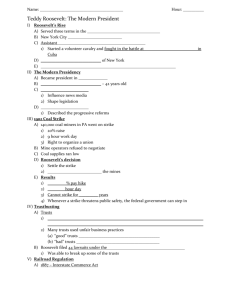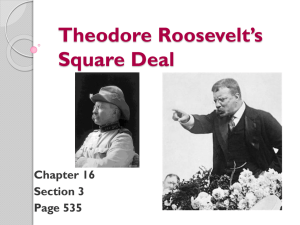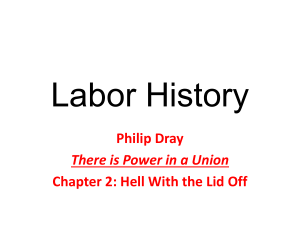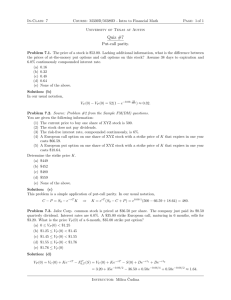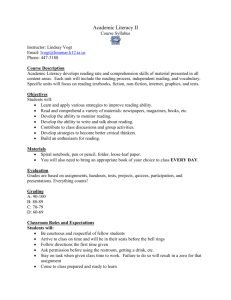The Anthracite Coal Strike of 1902
advertisement
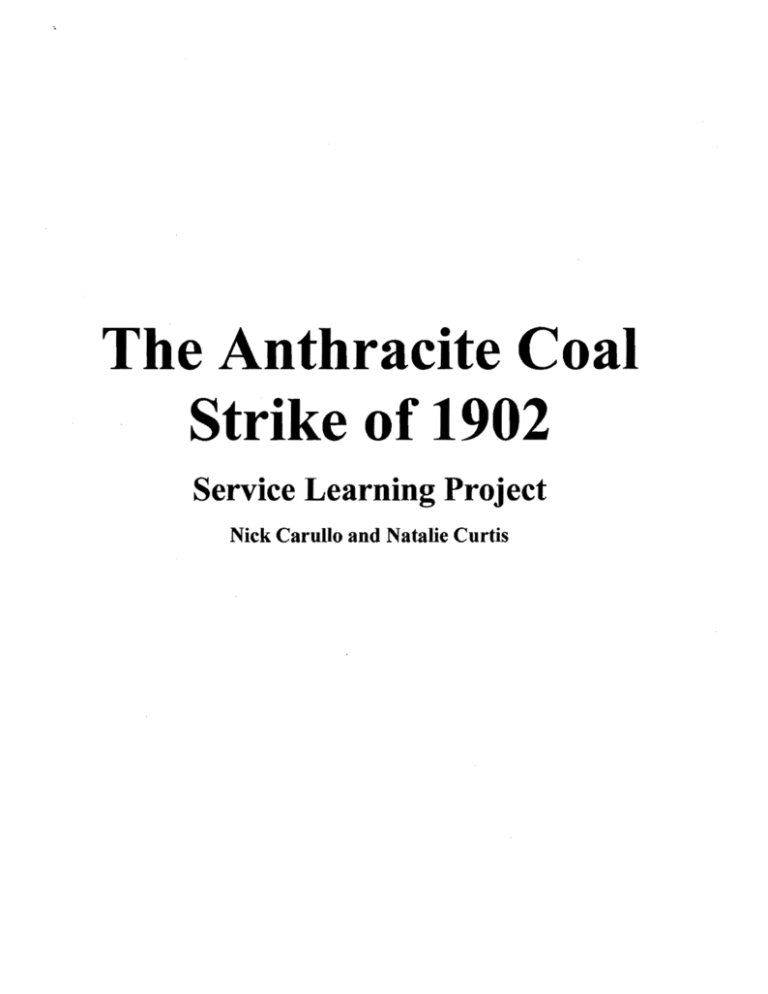
The Anthracite Coal Strike of 1902 Service Learning Project Nick Carullo and Natalie Curtis
PA State Standards: 8.2 Pennsylvania History
8.2.9. GRADE 9
Analyze the political and cultural contributions of individuals and groups to Pennsylvania history
from 1787 to 1914. IdentifY and analyze primary documents, material artifacts and historic sites
important in Pennsylvania history from 1787 to 1914. IdentifY and analyze how continuity and
change have influenced Pennsylvania history from the 1787 to 1914. IdentifY and analyze
conflict and cooperation among social groups and organizations in Pennsylvania history from
1787 to 1914.
8.2.12. GRADE 12
Evaluate the political and cultural contributions of individuals and groups to Pennsylvania
history from 1890 to Present. IdentifY and evaluate primary documents, material artifacts and
historic sites important in Pennsylvania history from 1890 to Present. IdentifY and evaluate how
continuity and change have influenced Pennsylvania history from the 1890s to Present. IdentifY
and evaluate conflict and cooperation among social groups and organizations in Pennsylvania
history from 1890 to Present.
Learning Objectives:
1. Students will identifY of the main people involved in the Anthracite Strike of 1902.
2. Students will explain how the federal government played a key role in ending the Anthracite Strike of 1902. 3. Students will analyze political cartoons and apply their understanding about the Anthracite Strike of 1902 accurately to their group members and the class. Materials Needed:
1. Copies of political cartoons for every student
2. Copies ofPA maps for every student
3. Computer that is hooked up to a projector to show a short video
Brief Introduction:
To get students involved before a lecture, ask them some basic questions about the PA coal
mining industry. Some questions to consider are:
1. What is anthracite coal?
2. Have you ever been to a coal mine?
3. Where are coal mines in P A?
4. Can you describe what a coal mine looks like?
Teacher will lecture on all the following sections: Brief history of the 1900
strike, Who, What, Where, When, and Why_
Brief history of the 1900 strike:
Anthracite mine workers went on strike to fight for better wages and hours. Operators
wanted to attack miners for their decision to go on strike, but Mark Hanna, Senator of Ohio,
persuaded operators to end the long-drawn-out conflict. This was completely a political move
because Republicans did not want the 1900 strike to affect their chances of re-election. A coal
strike would have hurt the Republicans because it was Republicans who controlled a great
portion of the coal mining industry. Operators and miners carne to a truce, but not a settlement.
Operators did not recognize their union (The United Mine Workers), but as a truce operators
gave them a 10% wage increase. Since demands were not met from 1900, a strike occurred in
1902. 1
Who
1. John Mitchell was the leader of the United Mine Workers; Mitchell carne to power in
1898. He was an important leader for the UMW because he helped consolidate miners'
interests. This was a very difficult task for Mitchell because the mining community was
very diverse. Mitchell helped miners overcome ethnic boundaries such as language and
culture and helped them unite under one common interest. Mitchell disapproved
radicalism and violence as a means to have miners' demands met. 2 He was also
completely willing to accept the findings of any commission appointed by President
Roosevelt. Mitchell faced criticism from George F. Baer, President ofthe Philadelphia
lMelvyn Dubofsky and Foster Rhea Dulles, Labor in America: A History (Wheeling, Illinois: Harlan Davidson, Inc.,
2010),171.
2
Ibid, 172.
and Reading Railroad, because Baer felt the UMW was responsible for the strike since
they were going against the free market economy.
2. George F. Raer was the President of the Philadelphia and Reading Railroad. He was a
tough hard boiled spokesman for the operators of the anthracite coal mines. 3 Baer
completely opposed the demands of the UMW because he felt it went against owners'
property rights. Furthermore, he opposed the demands of President Theodore Roosevelt.
Baer felt the federal government and the miners had no right to oppose the free market
economy his company belonged to. In response to the UMW and Roosevelt, Baer stated,
"The rights and interests of the laboring men will be protected and cared for, not by the
labor agitators, but by the Christian men to whom God and his infinite wisdom is giving
control of the property interests of the country and upon the successful management of
which so much depends.',4 Baer completely opposed the labor commission set up by
Roosevelt, and never acknowledged the UMW's existence. Because of Baer' s pride and
stubbornness, he was forced by President Roosevelt to come to a compromise with the
UMW.
3. Theodore Roosevelt, President of the United States of America during the 1902
anthracite coal strike who called attention to the conflict between Baer and the UMW.
Roosevelt's main concern was the health and wellbeing of the public. With the help of his
Commissioner of Labor Carroll D. Wright, Roosevelt was able to investigate the
anthracite conflict. The information collect by Wright gave Roosevelt insights to the
quarrel that led him to side with the mine workers. The strike started in June of 1902 and
Dubofsky and Dulles, 173. Mayo, Earl. 2010. liOn Strike!" OSU Department of History. http://ehistory.osu.edu/osu/mmh/LaborConflict/ OnStrike/default.cfm (accessed September 13, 2010). 3
4
was still continuing into early autumn. Roosevelt felt if the strike continued any further it
would be detrimental to the economy and Americans survival in the winter. On October
3, 1902, Roosevelt called a conference at the White House for settling the anthracite
strike between operators and strike leaders. Roosevelt pleaded "With all the earnestness
there is in me I ask that there be an immediate resumption of operations in the coal mines
in some such way as will meet the crying needs of the people."s Roosevelt wanted a
peaceful negation, but the operators didn't want to compromise. His last attempt to end
the strike was to intervene directly with federal troops taking over the anthracite mines of
P A. With Baer's options limited, he was forced to settle the labor dispute. If Roosevelt
did not intervene, it would have created a social conflict not only between the miners and
operators, but with the American public.
What
. This video from history. com accurately represents an overview of the 1902 Anthracite Coal
Strike. 6
What was gained from the Strike: Because of Roosevelt and Carroll Wright's
intervention, miners were given a ten percent wage increase and awarded an eight or nine hour
work day compared to the previous ten hour work days. It was not until March of 1903, five
months after miners went back to work that they received these benefits. Miners received
Grossman, Jonathan. 2010. "The Coal Strike of 1902 - Turning Point in U.S. Policy." United States Department of
labor. http://www.dol.gov/oasam/programs/history/coalstrike.htm (accessed September 21,2010).
6 A & E Television Networks. 2010. Theodore Roosevelt vs. Corporate America {Video}. http://www.history.com
!videos!theodore-roosevelt-vs-corporate-americamheodore-roosevelt-vs-corporate-america (accessed September
19,2010).
5
benefits but not everything they fought for. The UMW was not recognized by the coal operators;
however miners were happy with the settlement received. 7
Where
N
LEGEND
CAlIAOA - -
In~ematiooo1
- - Sla...
roM\S - - county
~- Shoreline
ff ~
~,.,. ~4: )"P.'t:ik"~
fEbE3i#$'
n
~
l(l
~
1,;:
1QMiie;.
NtfI~ AlIoouooanet>~;.dMWre$-a.~
stl til JMulBY 1.;woo.
MERCER
uKK) lAWRENCE
This is a map of Pennsylvania and its counties.s
Dubofsky and Dulles, 175. \vikimedia Commons. 2006. "File: US Census Bureau Pennsylvania County Map.png." Wikimedia Commons. http://commons.wikimedia.org!wiki/File:US_Census_Bureau_ Pennsylvania_CountLMap.png (accessed October 15,2010). 7
THE ANTHRACITE COAL BASINS "­ .7
SCHUYLKILL
r
.~'--.
'"
,I
.~
.,
.,..- .
BERKS
)
/
• READING
/
NORTHERN FIELD
MIDDLE FIELD
SOUTHERN FIELD
This is a map of the three anthracite coal regions in Pennsylvania.' The previous map will
help you locate where these counties are located in Pennsylvania.
Lattimer Massacre Project. 2010. "Lattimer in International News." http://lattimermassacre.wordpress.com/
category/period-text! (accessed October 4,2010).
9
Where- Luzerne County, Carbon County, and Schuylkill County were the three regions in
Pennsylvania that shaped the anthracite coal industry.lO
When
Events of 1902
June 2
Anthracite coal strike officially began
July
Newspapers began to report incidents of violence in the mining region
July 30
A storeowner was beaten to death by a mob while a deputy sheriff was
escorting two miners who refused to join the strike. The Pennsylvania
Governor began to call out militia to guarantee order.
August 21-30
Press commentary on letter by George F. Baer
October
Growing fear of a "coal famine" as winter approached
October 3
Roosevelt invited UMW leaders and operators to a White House conference
October 6
Entire Pennsylvania militia ordered to duty; eventually 8,750 men served in the
anthracite fields
October 8
Miners at mass meetings voted unanimously to continue the strike, belying the
operators' assertions that, if given police protection, the majority of miners
would go back to work
October 12
J.P. Morgan pressed George Baer to agree to arbitration of the strike
October 13
Roosevelt discussed with General John M. Schofield having he U.S. Army
seize the coal mines and operate them until such time as the owners agreed to
arbitration
October 14
J.P. Morgan met with Roosevelt regarding arbitration
October 16
Roosevelt announced the appointment of a commission to arbitrate the dispute
October 23
Miners returned to work
October 24
Arbitration commission met with Roosevelt
This timeline is directly taken from the internet on ehistory.l1
10 Grace Palladino, Another Civil War: Labor, Capital, and the state in the Anthracite Regions of Pennsylvania, 1840 -1868 (New York: Fordham University Press, 2006), 8. 11 Ehistory. 2010. "Chronology of the Anthracite Coal Strike of 1902.# OSU Department of History. http://ehistory.osu.edu/osu/mmh/gildedage/1902AnthraciteStrike/content/1902StrikeChrono.htm (accessed September 16, 2010). Why
Demands from the 1900 strike were not met - higher wages, better working conditions,
shorter hours, union recognition.
The system set up by c'oal operators kept workers dependent upon their employer. Systems
created by operators such as the company store and company housing made employers in
control even further over their employees. 12
From the miner's point of view, they agreed with the "labor of theory value." It was the
miners' labor that gave coal its value, so miners felt it was their right to fair wage and good
working conditions.
Annotative Bibliography:
Citizendium contributor. 2009. "Coal Strike of 1902." Citizendium.
http://en.citizendium.org/wiki ICoal:.....Strike_oC1902 (accessed September 14,2010).
These two political cartoons show the conflicts between big business (oligopoly
capitalism) and the American worker. Specifically, compromises had to be made through
federal involvement.
eHistory contributors. 2010. "Hurry Up and Take the Smaller One, Mr. Baer." eHistory @ The
Ohio State University. http://ehistory .osu.edulosulmmhlgildedageI1902anthracitestrike/content
lBaer.cfin (accessed October 4,2010).
This political cartoon shows the conflicts between big business (oligopoly capitalism)
and the American public.
Ehistory. 2010. "Chronology of the Anthracite Coal Strike of 1902." OSU Department of
History. http://ehistory.osu.edulosu Immhlgildedagel
1902AnthraciteStrike/contentl1902StrikeChrono.htm (accessed September 16,2010).
This time line serves as an overview of the events taking place in the year 1902 on the
1902 Anthracite Coal Strike.
12 Mayo, Earl. 2010. liOn Strike!" OSU Department of History. http://ehistory.osu.edu/osu/mmh/Laborconflict/
OnStrike/default.cfm (accessed September 13, 2010).
Grace Palladino, Another Civil War: Labor, Capital, and the state in the Anthracite Regions of
Pennsylvania, 1840 - 1868 (New York: Fordham University Press, 2006).
This book focuses primarily on coal strikes from 1840- 1868 in Pennsylvania. It connects
ethnicities, working conditions, labor struggles and political ties to the coal industry. The
struggles of the 1902 coal strike relate to the struggles and conflicts in Palladindo's book.
Grossman, Jonathan. 2010. "The Coal Strike of 1902 - Turning Point in U.S. Policy." United
States Department of Labor. http://www.doLgov/oasamJprogramslhistory/coalstrike.htm
(accessed September 21,2010).
This article provides an excellent description of the progressive principles used by Theodore
Roosevelt to help end the Anthracite Coal strike of 1902. The article provides a detailed
overview of politics, and shows Roosevelt's sympathy towards Pennsylvania Coal miners
and the American pUblic.
Lattimer Massacre Project. 2010. "Lattimer in International News."
http://lattimermassacre.wordpress.comlcategory/period-text! (accessed October 4, 2010).
This is a map of specific counties in Pennsylvania that have anthracite coal. Use both
maps to visualize what part of the state these coal counties are located.
Mayo, Earl. 2010. "On Strike!" OSU Department of History. http://ehistory.osu.edulosulmmh
lLaborConflictiOnStrike/default.cfm (accessed September 13, 2010).
The article "On Strike" is a descriptive overview ofthe 1902 Anthracite Coal Strike. The
article describes political, economic and social issues which complicated the strike.
Melvyn Dubofsky and Foster Rhea Dulles, Labor in America: A History (Wheeling, Illinois:
Harlan Davidson, Inc., 2010).
This source is a detailed overview of the 1900 and the 1902 Anthracite Coal Strike. It
talks about the connection between these two strikes, the politics involved during this
crisis, and how the strike was resolved.
Wikimedia Commons. 2006. "File: US Census Bureau Pennsylvania County Map.png."
Wikimedia Commons. http://commons. wikimedia.orglwikilFile: US_Census_Bureau_
Pennsylvania_County_Map.png (accessed October 15,2010).
This is a map of all the counties in Pennsylvania. Use both maps to visualize what part of
the state these coal counties are located.
Activity and Assessment using Political Cartoons:
Directions
• Pass cartoons out to groups of students and have them discuss the questions in mind
and how they relate to the 1902 coal strike.
Each group of students will answer these four questions about each political cartoon. Of
course, these are not the only questions each group has to answer.
1. Describe what you see in the political cartoons.
2. Who is/are portrayed in each political cartoon?
3. Which side of the argument is the cartoon favoring?
4. What does this cartoon show about public opinion?
First Political Cartoon. I3
13 Citizendium contributor. 2009. "Coal Strike of 1902." Citizendium. http://en.citizendium.org!wiki
/Coal_Strike_oC1902 (accessed September 14, 2010).
.. HtTfUU" tTl' ANI) 'l'.iIJ&:~c~~j~~t,:t!lt
FroIll the ·.~,,·e{itd..lt~l1~ (Yll!~l~).
Second Political Cartoon. 14
Third Political Cartoon. IS
eHistory contributors. 2010. "Hurry Up and Take the Smaller One, Mr. Baer." eHistory @ The Ohio State
University. http://ehistory.osu.edu/osu/mmh/gildedage/1902anthracitestrike/content/Baer.cfm (accessed
October 4, 2010).
14
15 Citizendium contributor. 2009. "Coal Strike of1902." Citizendium. http://en.citizendium.org/wiki
/CoaLStrike_oC1902 (accessed September 14, 2010).
